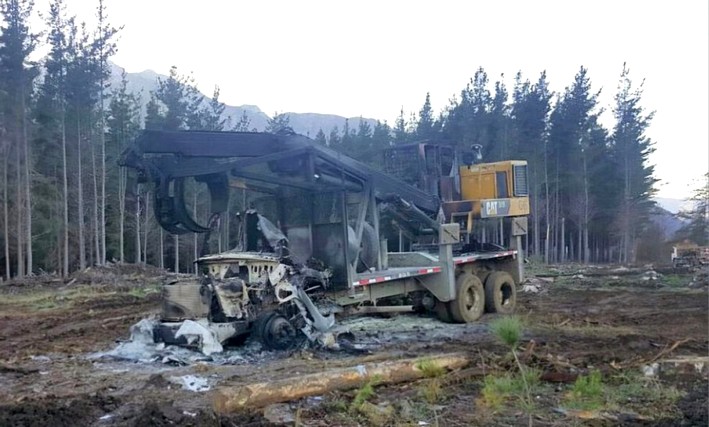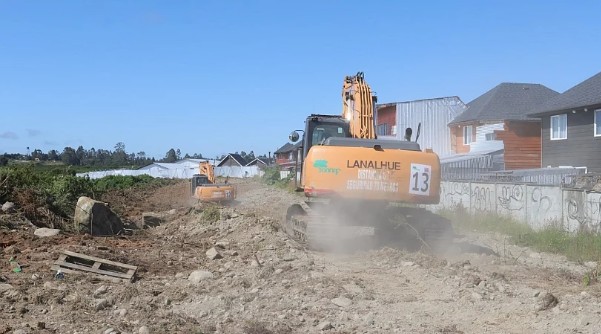Attacks, Fires, and Thefts: The Numbers of Assaults and What to Expect in 2023
This Tuesday, the Araucana property, located on the route between Los Álamos and Cañete in Arauco, recorded the first attack of 2023 against forestry companies. Six masked individuals armed with weapons entered the premises, resulting in the burning of a forestry tractor and a pickup truck, as well as the theft of four chainsaws. This marked the end of a 16-day streak without forestry attacks, which had been the best start to a year since 2014.
The figures recorded in the sector
René Muñoz, manager of the Association of Forestry Contractors (Acoforag), points out that of the 430 attacks recorded by the association from 2014 to 2022, last year was the most violent with 106 attacks. Of these, 104 took place in the Southern Macrozone, one in the Ñuble region, and one in the O’Higgins region.
Additionally, Muñoz asserts that 2022 saw the most violent month in nine years, with 17 attacks in April alone—meaning a forestry operation was attacked, a truck was burned on a public road, or a bus transporting forestry workers was shot at every 1.8 days (on average).
Since 2014, the expert explains, the curve of attacks has shown a steady and sustained increase, starting with five attacks that year and reaching 106 in 2022, as previously mentioned.
The Acoforag manager states that all this violence has left a significant trail of destruction, including major effects such as:
• The impact on 41,000 forestry workers and their families, meaning that over nine years of conflict, approximately 120,000 people living in the Southern Macrozone and connected to the forestry sector have been affected.
• 400 forestry contractors have been targeted in these attacks by armed groups.
• An average of four attacks per month since 2014—meaning every 7.5 days, a forestry contractor was attacked, their assets destroyed, and their projects undermined.
• Between 2014 and 2022, 1,540 trucks and forestry equipment were destroyed or burned (32% trucks and 68% forestry equipment).
Regarding rural violence, last year, the High Complexity Prosecutor's Office of La Araucanía handled 68 cases linked to the "forestry" category, including threats (4), property damage (1), unjustified shootings (1), homicide (1), fires (43), theft or robbery (13), and land occupation (5).
The president of the Multigremial of La Araucanía, Patricio Santibáñez, notes that attacks are primarily concentrated in the Malleco province of La Araucanía and the Arauco province in the Biobío region. He also emphasizes that 2022 saw the highest number of arson attacks against the Los Ríos Region.
"The absence of the State, weak oversight, and lack of police protection have allowed radicalized groups to grow. Today, there are six organizations that have claimed attacks on forestry companies and contractors: Coordinadora Arauco Malleco, Weikan Auka Mapu, Coordinadora Mapuche Malleco, Resistencia Mapuche Lafquenche, Resistencia Mapuche Malleco, and Liberación Nacional Mapuche," states Santibáñez.
Regarding monetary losses, René Muñoz reports that over nine years (2014–2022), the total reached 174.195 billion pesos, solely due to destroyed equipment. According to Acoforag, the years with the highest losses were:
• 2020, with an annual loss of 35.676 billion.
• 2021, totaling 41.422 billion in losses.
• 2022, reaching 39.766 billion.
Possible Measures and Projections for 2023
Muñoz highlights the importance of the Timber Theft Law, which classifies this action as a crime and increases penalties for offenders, arguing that this regulation has improved the effectiveness of prosecutors in handling these cases.
Additionally, the Acoforag manager notes that there is greater social condemnation of the climate of violence in the area, including the use of terms like "terrorism and delinquency." In this regard, he asserts that significant arrests of terrorists, groups, and illegal associations involved in timber theft have been made, expressing optimism for the future.
"It is essential to incorporate new legal frameworks to complement the work of police and prosecutors, such as laws on land usurpation and critical infrastructure. With these, we hope to continue dismantling these terrorist and armed groups that had found their operational base in the Southern Macrozone," states Muñoz.
Patricio Santibáñez explains that this year, the effects of implementing effective measures against violence are being observed. He notes that the State of Emergency and the Timber Theft Law have helped disarm and remove the machinery used for these illegal activities. Additionally, the president of the Multigremial of La Araucanía adds that it is crucial to initiate a dialogue process involving all stakeholders—local mayors, governors, victims, Mapuche, and non-Mapuche individuals—originating from the region itself.
"We believe it is very important to advance the legislative agenda addressing these serious issues, such as the regulations mandated by the Timber Theft Law, and to push forward bills on land usurpation and critical infrastructure, given the positive results already seen with the partial enactment of the timber theft law," says Andrés Meneses, research manager of the Chilean Wood Corporation (Corma).
Marco Zecchetto Rocco, published onwww.emol.cl

















